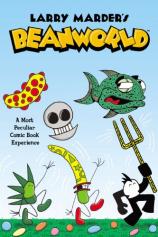Beanworld, Book 1: Wahoolazuma!
Review
Beanworld, Book 1: Wahoolazuma!
My review for Larry Marder’s first collected edition of Beanworld will undoubtedly suffer from numerous instances of backhanded compliments. I thought I’d get that caveat out of the way before I got ahead of myself. To be perfectly honest, when I started reading BEANWORLD, my first thought was “What is this?” But by the end, I was sorely disappointed that my visit to this very odd place had ended. Beanworld seems simple and even juvenile at first, but underneath its childlike veneer lays a rich and complex narrative.
I wish I had a better grasp of Marxist critical theory, because I think I could have a field day if I examined Beanworld through such a lens. Now I’m going to try to sound smart: The inhabitants of Beanworld (the world, not the book) operate in a sort of socialist collective wherein all inhabitants have their own prescribed roles, which they dutifully perform in exchange for food. There’s no currency exchanged --- some beans are soldiers who hunt down “chow” to be consumed from the “chowdown pool”; other beans are musicians, artists, or scientists, all of whom do their part to ensure that the society runs smoothly. The de facto leader of the beans is Mr. Spook, though he himself is deferential to the beans’ spiritual guide, Gran’Ma’Pa, who maintains a silent visage over the beans and also provides them with the resources to secure the aforementioned chow.
In writing (and rereading) the previous paragraph, it strikes me how altogether odd the book still sounds, even though I’d gotten through my initial feelings of confusion when I read it. BEANWORLD is the kind of book that only makes sense after you immerse yourself in it and put away your hangups about what a story ought to be. The illustrations are simplistic in terms of the level of detail they display. But their lack of detail, and their dependence on a cartoony-style, allows readers to more easily identify with the characters, enabling them to imprint their own identities on the mostly featureless characters. They’re drawn so simplistically, in fact, that the gender of each character is only discernable by the pronouns other characters use to refer to them (with the one exception of Mr. Spook). This simplicity seems like a problem at first, in that the whole enterprise seems the work of an amateur. But after a very short time readers will begin to see the depth that the figures belie.
You probably shouldn’t read this if you're looking for a relaxing, leisurely book. BEANWORLD requires an active reader in order to fully appreciate all it has to offer. It wouldn't be a stretch to suggest this as a required text at many educational levels; younger readers can learn the basics of how societies function, while students at higher levels can delve deeply into socioeconomic theory, and alternative socioeconomic structures. BEANWORLD is strange, and somewhat off-putting, but ultimately it is one of the more rewarding and unique comics experiences you'll encounter.
Reviewed by Brian P. Rubin on October 18, 2011
Beanworld, Book 1: Wahoolazuma!
- Publication Date: March 10, 2009
- Genres: Graphic Novel
- Hardcover: 272 pages
- Publisher: Dark Horse
- ISBN-10: 1595822402
- ISBN-13: 9781595822406



